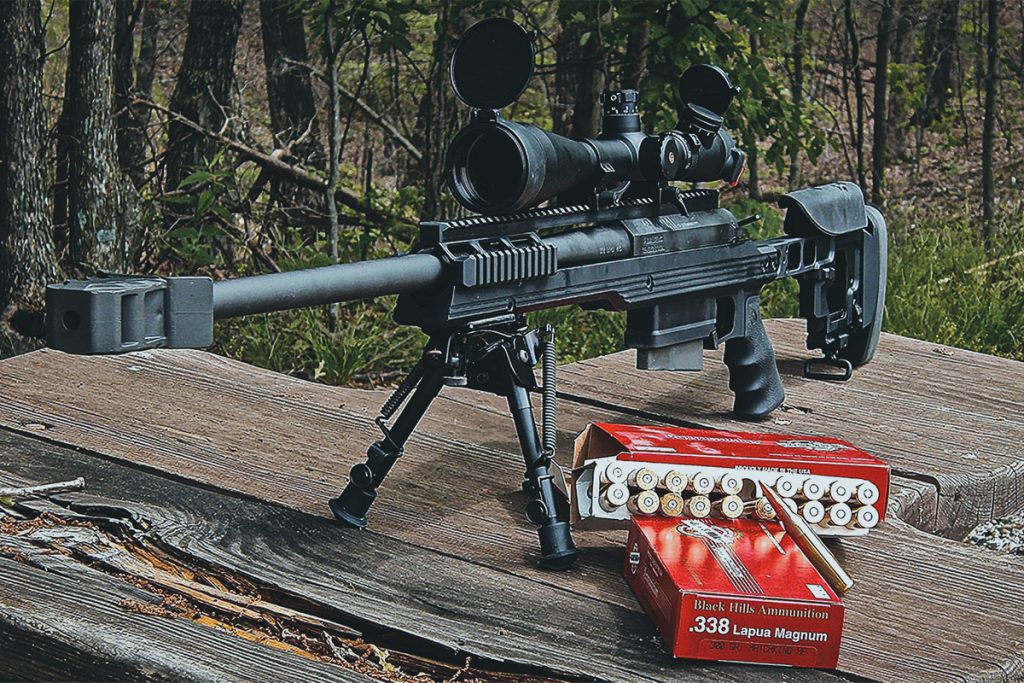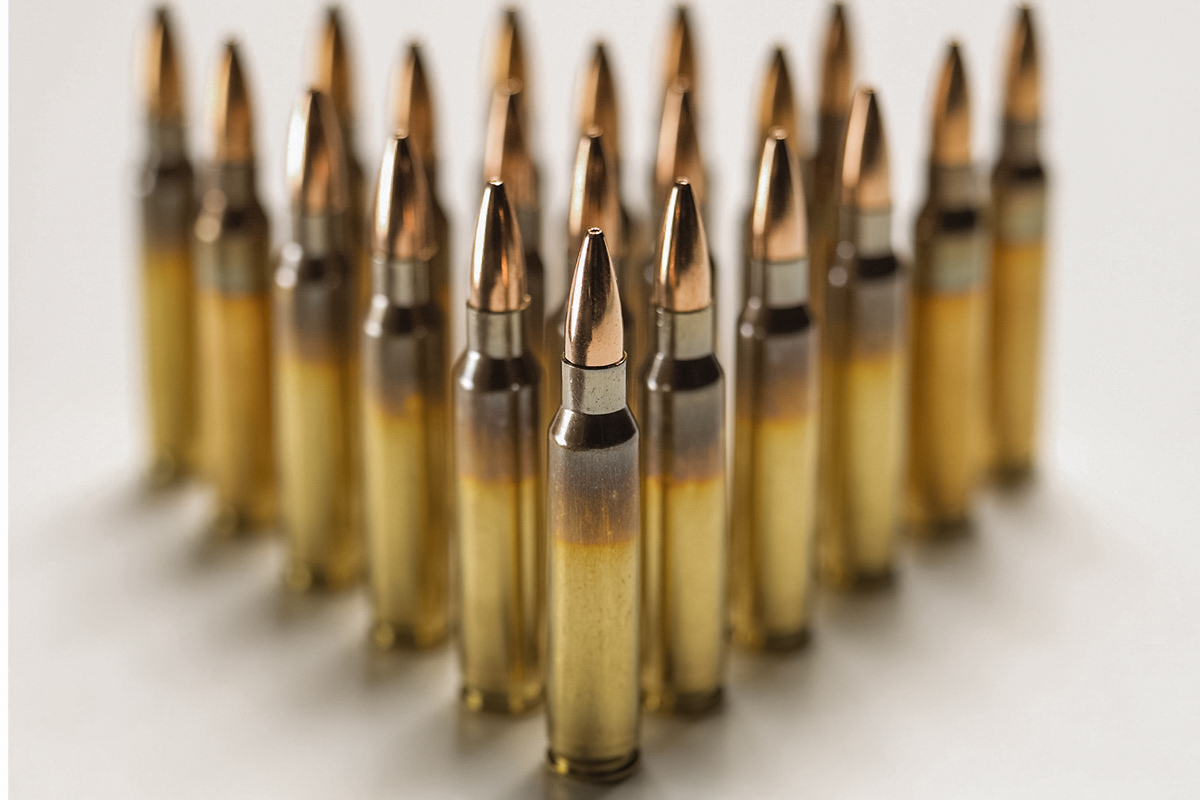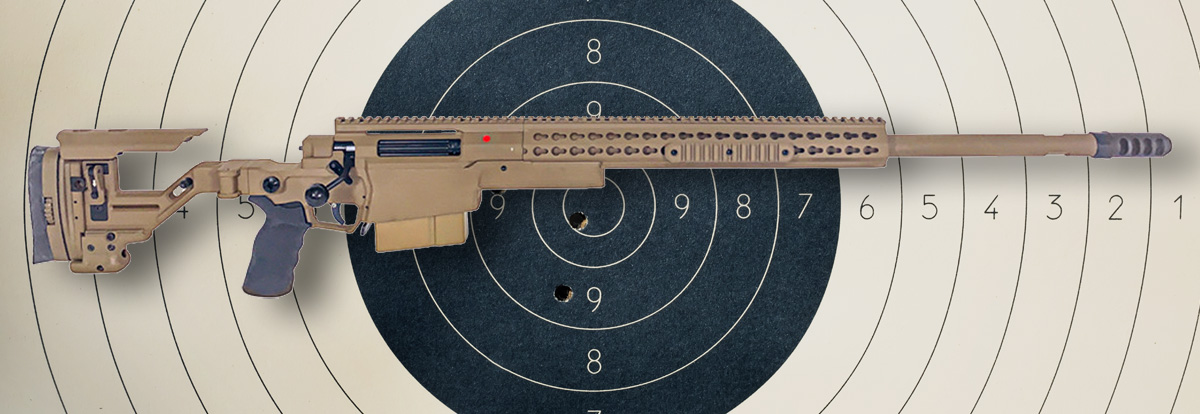What do rounds like the .45-70, .30-06, .308, and 5.56 have in common? They’re all popular hunting loads that got their start as military ammunition. Getting a thumbs-up from the Pentagon takes time, and so does gaining traction in the open market. After early development in the 1980s, the 338 Lapua Magnum (commonly referred to without the “magnum”) is getting more and more attention in the civilian world, and the buzz is well-deserved.
If you’re not familiar with the 338 Lapua, don’t feel too bad. It’s a bit of a niche caliber that most shooters will never have an opportunity to use, let alone push to its potential. Those few who get a chance to squeeze every bit of juice out of it are in for a treat.

The 338 Lapua is a blazingly fast, flat-shooting, and hard-hitting cartridge that can make hunters and competition shooters feel superhuman. It’s got the skins on the wall and trophies on the shelf to prove it. But what makes it so great, and who should consider buying a rifle chambered for 338 Lapua? Switching over to a new rifle, scope, and ammunition isn’t cheap. Add to that the learning curve of a new platform.
Let’s dig into the caliber’s history, specs, and some of the available firearms to make sense of all the hype.
GOOD GEAR – Whenever You’re in the Field or on the Go, Drink BRCC Instant Coffee
Origins of the 338 Lapua

The 338 Lapua traces its lineage back to great American hunters, Finnish engineers, and the U.S. Navy. In the early 1980s, the Navy began shopping around for a cartridge that could deliver terminal effects between those of a .308 (and the .300 Win Mag that was beginning to see use in sniper rifles at the time) and the mighty .50 BMG, with range to match. Considering the .308’s limitations arise just shy of 1,000 meters and the .50 BMG’s ability to reach well beyond 2,000 meters, 1,500 meters would have been a solid benchmark for the new round.
To achieve this, Research Armament Prototypes (RAP) turned to an idea that Champlin Haskins Firearms had been kicking around since the 1960s. In the two decades preceding the Navy’s search for a new sniper cartridge, Doug Champlin and Jerry Haskins worked with Elmer Keith (father of the 44 Magnum) to put a .338-caliber bullet in a necked-down .416 Rigby case.
The team hoped its wildcat rounds could combine the power of the proven dangerous game round with a lighter projectile to yield increased range and accuracy while maintaining a high level of stopping power. After all, if there was one thing Keith wouldn’t suffer, it was an underpowered hunting cartridge.

Problems arose when ammunition neared the Navy-mandated muzzle velocity goal of 3,000 feet per second. RAP brought in Finnish ammunition manufacturer Lapua to refine the cartridge. While upgraded prototypes performed well, slightly below the muzzle velocity benchmark, breaking the threshold resulted in case failures that ultimately scuttled the project in 1986.
The U.S. military ended up purchasing rifles chambered for 338 Lapua in small batches but not in the large numbers originally planned.
Fortunately for us, Lapua saw potential in the round beyond the failed military venture and continued its development. The Commission Internationale Permanente certified the 338 Lapua Magnum as a sanctioned cartridge in 1989. The round gained a bit of a cult following in hunting and precision long-range shooting communities, where it earned a reputation for range, accuracy, and exceptionally flat trajectory.

While the U.S. military has had a hot-and-cold relationship courting the 338 Lapua, foreign militaries have used it with great success. In 2009, Sgt. Craig Harrison, then a sniper in the British Army, killed two insurgents at a distance of 2,475 meters with a 338 Lapua rifle. Those shots make up one chapter of his impressive story, which I encourage you to hear.
RELATED – Hunting Alaska With the New Silencer Central Banish Backcountry
338 Lapua Specs and Ballistics
Early blueprints for the 338 Lapua didn’t start on a blank drawing board. Champlin Haskins Firearms originally modified the .416 Rigby case to accept a .338-inch diameter bullet. Later iterations used modified .378 Weatherby cases. Up until Lapua adopted the cartridge, it went under the designation of .338-416. Because of the 338 Lapua’s overall length of 3.681 inches, it qualifies as a magnum-length cartridge.

Today, a quick search will yield bullet weights ranging from 250 to 300 grains. Ammunition selection is important because not all loads are suitable for hunting. Due to the price of new factory ammunition, hand-loading is popular among 338 Lapua shooters.
Using Lapua’s 250-grain Scenar target ammunition as an example, the 338 Lapua’s velocity measures 2,970 fps at the muzzle, slows to 1,666 fps at 1,000 yards, and remains above the supersonic threshold of 1,100 fps with a bullet velocity of 1,171 fps at 1,500 yards. The same bullet will produce 4,896 foot pounds of energy at the muzzle, 1,540 ft-lb at 1,000 yards, and 761 ft-lb at 1,500 yards.
The same properties that allow the bullet to maintain speed also keep its trajectory relatively flat and straight. When fired from a 27-inch barrel on a rifle zeroed at 100 yards, the same bullet will drop 258 inches at 1,000 yards and 797 inches at 1,500 yards.
GOOD GEAR – Gift a Patch for the Perfect Marksman With the BRCC Pew Professional PVC Patch
Production Firearms Chambered for the 338 Lapua
The 338 Lapua is a narrowly focused round that requires a magnum-length action, so the rifles that shoot it are fairly uniform in design. Get used to seeing bolt-action rifles with top-shelf components and long barrels.
Savage 110 Precision

Some of you are thinking, “$1,649 is a little rich for my blood.” Buckle up because the Savage 110 Precision is the budget gun of this group. That kind of money will get you a stock that’s adjustable for height and length of pull, a trigger that’s adjustable from 1.5 to 4 pounds, and a 24-inch carbon-steel barrel in a heavy profile threaded for the included brake or a suppressor.
Savage’s 110 action has been around for decades, so there should be no surprises there. This rifle is accurate, handles the 338 Lapua well, and is affordable compared to the alternatives out there.
McMillan TAC-338

Does the McMillan TAC-338 look familiar? This is one of the sniper rifles used by Chief Petty Officer Chris Kyle, and it got notable screen time in the 2014 biographical film American Sniper. You can have one of your own for an MSRP of $6,428.
The TAC-338 has a much more traditional appearance than a lot of modern precision rifles, but the cheekpiece and trigger are adjustable. The 27-inch stainless-steel match-grade barrel delivers tack-driving accuracy, and the medium-heavy profile should save a little weight when you’re lugging this rifle through the mountains searching for elk.
Accuracy International AXSR

The Accuracy International AXSR is a civilian variant of a sniper rifle the company builds for military use. The long Picatinny rail and key mod handguard provide plenty of room for optics and accessories. The 27-inch match-grade barrel maximizes the 338 Lapua’s potential for range and accuracy.
Not only is the stock adjustable for height and length of pull, but it also folds for easier storage and transportation. Yes, it’s excellent; and yes, it’ll cost you dearly. Expect to pay nearly $10,000 for an AXSR.
RELATED – 7mm PRC: Savage Expands Rifle Lines for New Cartridge
What Is a 338 Lapua Good For?
In the most basic terms, the 338 Lapua is good for delivering a very heavy punch to a target that’s very far away. Remember that it was originally developed for snipers who needed to engage hostile targets at distances exceeding 1,000 yards. In civilian terms, the 338 Lapua is an excellent competition rifle for long-range shooters. It’s also a potent cartridge for hunters pursuing big game like elk, moose, and bear.
The round’s extra reach can create valuable standoff distance when hunting dangerous game. Due to the cost of ammunition and rifles chambered for 338 Lapua, the cartridge is best suited to serious shooters who want to pay for premium performance.
GOOD GEAR – Jump Into Your Daily Routine With This Kick-Ass BRCC Coffee Saves Mug
Which Is Better: .50 BMG or 338 Lapua?

Considering that the 338 Lapua came from a desire to have an alternative to the .50 BMG, this is a logical comparison to make. That said, there probably aren’t many people cross-shopping the two calibers and struggling to make up their minds. In terms of outright power, the .50 cal takes the cake. With more than 2.5 times the case capacity, a .50-caliber rifle will propel a much larger bullet to higher speeds over longer distances and carry a vast energy advantage than a 338 Lapua rifle.
Bigger isn’t always better, though. The .50 BMG is a punishing round on the rifle and the person behind the trigger. You’ll have to carry a beast of a rifle and develop a tough shoulder to handle all that recoil. A rifle chambered for 338 Lapua will be much lighter.
It is also considered better for hunting because it can deliver plenty of power for big-game animals without becoming excessive. Neither caliber is good for shooters who don’t enjoy paying out the nose for ammunition, but choosing 338 Lapua will get you access to a wider variety of ammunition.
RELATED – Proof Research Barrels Are on the New Savage Mountain Hunter
What Is the Difference Between .308 and 338 Lapua?

The .308 is a proven round with extensive military, competition, hunting, and recreational use. It’s popular for a reason, but it can’t hold a candle to the 338 Lapua in terms of long-distance shooting. The two calibers have similar bullet diameters, but the 338 Lapua can take advantage of much heavier bullets thanks to a case capacity that’s more than double that of the .308.
The result is a trajectory that shoots much flatter past 500 yards, and some side-by-side testing shows the 338 Lapua shooting as much as 56 inches higher than the .308 at 700 yards.
Considering things like ammunition prices and availability, barrel life, and the kinds of rifles in production, the .308 is still a compelling option for most shooters. People who don’t regularly shoot beyond 500 yards don’t have a lot of incentive to spend more to shoot a precision rifle chambered for 338 Lapua. Those who do have an easy decision to make because the 338 Lapua is a vastly superior long-distance round.
GOOD GEAR – Visit a Safe Space Near You With the BRCC F.Y.S T-Shirt
Which Is Better: .300 Win Mag or 338 Lapua?

Of the cartridges commonly compared to the 338 Lapua, the .300 Win Mag is the most similar. While it shares its bullet diameter with the .308, the .300 Win Mag has an overall length that’s more than half an inch greater. The increased case capacity makes the .300 Win Mag much better competition for the speedy 338 Lapua. Still, the 338 Lapua is slightly larger in all physical dimensions.
The CIP and Sporting Arms and Ammunition Manufacturers’ Institute (SAAMI) list different figures for maximum average pressure but concur that the .300 Win Mag generates slightly less pressure than the 338 Lapua.
In the air, the 338 Lapua enjoys a much flatter trajectory beyond 1,000 yards than the .300 Win Mag. This may not be relevant for hunters, but it’s useful for competitive shooters. What hunters can appreciate is a serious advantage in kinetic energy. A 250-grain bullet fired from a 338 Lapua can carry more energy at 500 yards (3,061 ft-lb) than a 180-grain bullet fired from a .300 Win Mag at 100 yards (3,028 ft-lb).
Even if you never shoot to 1,000 yards or beyond, the extra knock-down power of the 338 Lapua might be a worthwhile upgrade for hunting extra large or dangerous game animals. For anything smaller, .300 Win Mag is more than adequate.
READ NEXT – 6mm ARC: A Compact Long-Range Round You Should Know About










Comments